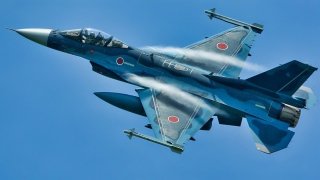Japan's F-2 Viper Zero: The F-16 Clone That Is a Remarkable Powerhouse
If the Mitsubishi F-2 looks strangely familiar, it should; she is indeed a clone of the General Dynamics now Lockheed Martin F-16 Fighting Falcon, AKA "Viper.”
Japan's Mitsubishi F-2 Origins and Specifications - If the Mitsubishi F-2 looks strangely familiar, well, it should; she is indeed a clone of the General Dynamics now Lockheed Martin F-16 Fighting Falcon, AKA "Viper” (the latter is the preferred sobriquet of her pilots, navigators, and crew chiefs alike).
As with the F-15J, the F-2 is built under license by Mitsubishi Heavy Industries, the same company that built the famous A6M “Zero” fighter plane of WWII.
Indeed, the F-2 has been dubbed the “Viper Zero” as an homage to both the Stateside-built Vipers and the original Zero alike.
The Viper Zero made her maiden flight on 7 October 1995 – 21 years after the original F-16 did so – and entered into official operational service with JASDF in 2000. A total of 98 airframes were built between 1995 and 2011.
As noted by the official Lockheed Martin info page on the warbird:
“The F-2 was also the first production fighter to be equipped with an Active Electronically Scanned Array (AESA) radar. In 2015, the F-2 became the eighth aircraft platform to be equipped with Lockheed Martin’s Sniper Advanced Targeting Pod…The F-2 has a wing area that is enlarged approximately 25 percent over the F-16 wing area. The larger wing allows more internal fuel storage and two more weapon store stations than the F-16…In addition to the larger wing area, the F-2 fuselage is approximately 17 inches longer than that of the F-16. The horizontal tails are also larger.”
Max airspeed is 1,320 miles per hour/Mach 2.0.
Armament consists of the JM61A1 variant of the 20mm Vulcan autocannon, and a maximum weapon load capacity of 8,085 kilograms, which can be manifested via any of the following: air-to-air missiles (AAMs) such as the Japanese-made AAM-3, AAM-4, AAM-5, or the U.S.-made AIM-9 Sidewinder and AIM-7 Sparrow; air-to-surface ordnance such as ASM-1 and ASM-2 antiship missiles, and Joint Direct Attack Munitions (JDAMs).
F-2 vs. North Korean Fighters?
So then, it is time to ask the same questions about Japan’s F-2 that we asked about the F-15J stack up against the jet fighters of China’s People’s Liberation Army Air Force (PLAAF) and North Korea’s Korean People's Army Air and Anti-Air Force (KPAAF)
F-2 vs. North Korea
Bottom line up front (BLUF), in a hypothetical shooting war over the Korean Peninsula or the Sea of Japan, the superbly well-trained JASDF Viper Zero drivers would devour their North Korean adversaries’ birds.
The Korean Communist fighter pilots have the quantity – over 900 combat aircraft — but not the quality, in terms of the planes themselves or the pilot training; that saying “Quantity has a quality all its own” only goes so far.
The DPRK’s most sophisticated fighter plane is the MiG-29 “Fulcrum,” which theoretically is the equal of the F-15 and actually slightly superior to the F-16.
However, variants of these planes have come up short against the Fighting Falcon/Viper in practice, as demonstrated during Operation Allied Force over Kosovo, whereupon U.S. Air Force and Royal Dutch Air Force F-16 drivers alike scored multiple air-to-air kills against Serb-piloted Fulcrums without sustaining any losses of their own.
It only gets worse for Kim Jong-un’s flyboys from there, as they’re stuck with the ignominious MiG-23 “Flogger” and Vietnam War vintage MiG-21 Fishbed, Chengdu J-7, Shenyang J-5, and Shenyang J-6.
F-2 vs. Chinese Fighters?
When it comes to a theoretical matchup between the Viper Zero and Xi Jinping’s PLAAF flying goons, the degree of confidence on behalf of the goods guys become a tad bit less certain.
To be sure, the PRC’s aerial arsenal also has its fair share of older fighters such as the 1969-vintage Shenyang J-8 “Finback” and the aforementioned J-7.
But, consistent with Beijing’s massive military modernization efforts, the PLAAF has considerably more sophisticated warbirds in its fighter plane arsenal, such as Sukhoi’s Su-27 “Flanker,” Su-30MKK “Flanker-G,” and Su-35 “Flanker-E,” as well as the homegrown Chengdu J-10 and Shenyang J-11 and J-16 clone of those aforementioned Russian-designed fighters.
These newer planes should, on-paper at least, put Communist Chinese pilots on a greater or equal footing with their would-be Japanese adversaries.
Though admittedly, the actual combat performance of the Sukhois in the skies of Ukraine might cast some reasonable doubt upon that on-paper equalness/superiority.
The far greater concern to a Fighting Falcon/Viper Zero driver, be he/she USAF or JASDF, would be the J-20 (“Mighty Dragon”), which is China’s entry into the 5th Generation stealth fighter race. At least some aviation experts declare it to be the most capable aircraft deployed by any nation in the USINDOPACOM area of responsibility (AOR).
The J-20 is meant to tangle with the F-22 Raptor and F-35 Lightning II, so that in turn translates to a significant degree of superiority over any variant of the F-16.
Only time will tell if, when, or how these theoretical matchups would play out in cold hard reality.
About the Author
Christian D. Orr is a former Air Force Security Forces officer, Federal law enforcement officer, and private military contractor (with assignments worked in Iraq, the United Arab Emirates, Kosovo, Japan, Germany, and the Pentagon). Chris holds a B.A. in International Relations from the University of Southern California (USC) and an M.A. in Intelligence Studies (concentration in Terrorism Studies) from American Military University (AMU). He has also been published in The Daily Torch and The Journal of Intelligence and Cyber Security. Last but not least, he is a Companion of the Order of the Naval Order of the United States (NOUS).


